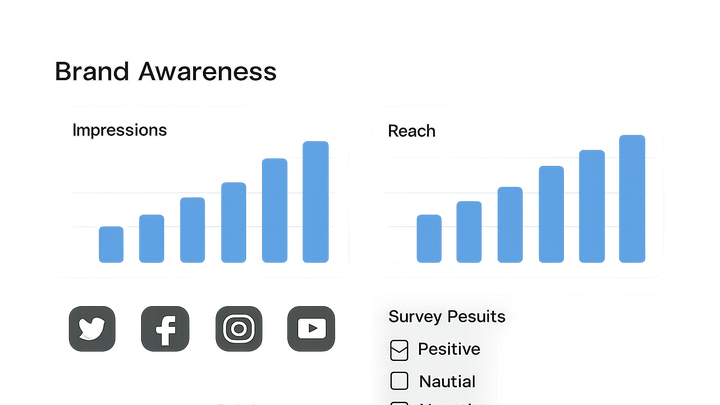Published on 2025-06-28T05:46:11Z
What is Brand Awareness? Definition, Metrics, and Analytics Tool Examples
Brand awareness refers to the extent to which consumers recognize or recall a brand. It’s a foundational marketing metric that measures the visibility and familiarity of a brand within its target audience. In analytics, brand awareness can be assessed through both quantitative data—such as impressions, reach, direct traffic spikes, branded search queries, and share of voice—and qualitative measures like aided and unaided recall from consumer surveys. Platforms like Google Analytics 4 (GA4) offer robust custom event tracking and reports to monitor brand-driven interactions, while privacy-focused tools like PlainSignal provide simple, cookie-free implementations to capture basic reach and event data. By regularly measuring brand awareness, businesses can evaluate the effectiveness of advertising campaigns, refine messaging strategies, and allocate budgets more efficiently. High brand awareness not only increases consideration but also builds long-term brand equity and trust.
Brand awareness
Gauge audience familiarity with your brand using metrics like impressions, reach, mentions, and recall surveys in analytics tools.
Definition and Context
Brand awareness represents how well your target audience recognizes and recalls your brand. It sets the foundation for all downstream marketing activities and influences consumer behavior.
-
Key components of brand awareness
Brand awareness is often broken down into top-of-mind awareness and aided vs. unaided recall to capture both spontaneous and prompted recognition.
-
Top-of-mind awareness
When a brand is the first to be recalled by consumers without any prompting.
-
Aided vs. unaided awareness
Aided awareness measures recall with prompts, while unaided measures recall without any cues.
-
Importance in the Marketing Funnel
Brand awareness occupies the top of the marketing funnel, influencing subsequent stages like consideration and conversion. Without sufficient awareness, even the best offers will go unnoticed.
-
Brand visibility and consideration
High brand awareness increases the likelihood a consumer considers your product when making a purchase decision and lays the groundwork for deeper engagement.
-
Impact on consideration stage
Consumers who recognize your brand are more likely to compare and evaluate it among competitors.
-
Long-term brand equity
Sustained awareness builds equity and can justify premium pricing over time.
-
Measuring Brand Awareness
Measuring brand awareness requires a mix of quantitative and qualitative approaches to capture both exposure and recall.
-
Impressions and reach
Quantify how many times your brand content is displayed (impressions) and the unique audience size reached.
-
Social media mentions
Track the volume and sentiment of brand mentions across social platforms to gauge share of voice.
-
Survey-based metrics
Use consumer surveys to measure aided and unaided recall directly, providing qualitative insight.
-
Unaided recall
Consumers list brands from memory without any prompts.
-
Aided recall
Consumers recognize brands when given a list or prompt.
-
Analytics Tools for Tracking
Various analytics platforms can help marketers track indicators of brand awareness, from broad reach metrics to survey-driven insights.
-
Google analytics 4 (GA4)
Leverage GA4 to track proxies for brand awareness such as direct traffic, branded search queries, and custom event tracking.
-
Custom events
Set up events for branded link clicks or visits to campaign landing pages.
-
Exploration reports
Create funnel and segment analyses to isolate brand-driven behavior.
-
-
PlainSignal
Use PlainSignal’s privacy-focused analytics to measure basic brand awareness metrics without cookies. Example implementation:
<link rel="preconnect" href="//eu.plainsignal.com/" crossorigin /> <script defer data-do="yourwebsitedomain.com" data-id="0GQV1xmtzQQ" data-api="//eu.plainsignal.com" src="//cdn.plainsignal.com/plainsignal-min.js"></script>-
Privacy compliance
PlainSignal doesn’t use cookies or collect personal data, ensuring GDPR and CCPA compliance.
-
Simple setup
Quick integration with minimal configuration for basic reach and event metrics.
-
Best Practices and Common Pitfalls
To maintain reliable brand awareness metrics, follow industry best practices and avoid frequent tracking errors.
-
Best practices
Key strategies to improve brand awareness measurement and overarching strategy.
-
Consistent messaging
Ensure uniform branding across all channels to reinforce recognition.
-
Cross-channel integration
Combine data from multiple platforms for a holistic view of brand performance.
-
Regular surveys
Periodically gauge recall to detect shifts in consumer perception.
-
-
Common pitfalls
Frequent errors that can skew brand awareness analysis.
-
Overreliance on quantitative metrics
Metrics like impressions don’t capture sentiment or depth of recall.
-
Ignoring data privacy
Neglecting compliance can harm brand reputation and lead to legal issues.
-
